 Books for kids on the lower end of elementary school have improved over the years. Sasquatch and Aliens: Alien Encounter, a chapter book by Charise Mericle Harper has real wit and a legitimate story line. (Well, except for the underwear business at the beginning, which, though fun, sort of peters out.) Two boys, who are not exactly made for each other, stumble upon an alien in the woods. And later a sasquatch. And there's a logical explanation. One that is just a little bit disturbing.
Books for kids on the lower end of elementary school have improved over the years. Sasquatch and Aliens: Alien Encounter, a chapter book by Charise Mericle Harper has real wit and a legitimate story line. (Well, except for the underwear business at the beginning, which, though fun, sort of peters out.) Two boys, who are not exactly made for each other, stumble upon an alien in the woods. And later a sasquatch. And there's a logical explanation. One that is just a little bit disturbing.
Cartoons are liberally sprinkled throughout Sasquatch and Aliens. They do more than illustrate. They carry some of the story, replacing traditional text in the narrative. That ought to make this book attractive to readers who may not be that fond of reading.
Viewing: Blog Posts Tagged with: Books for Younger Kids, Most Recent at Top [Help]
Results 1 - 22 of 22
Blog: Original Content (Login to Add to MyJacketFlap)
JacketFlap tags: 2014, Reader response, Books for Younger Kids, Add a tag
Blog: Original Content (Login to Add to MyJacketFlap)
JacketFlap tags: eBooks, Reader response, Books for Younger Kids, 2013, Add a tag
I'm not big on reading holiday books these days. I'll often think that it would be nice to read something related to Christmas during December, but my mind runs to things like Hogfather and I never get around to reading even those. I ended up reading Zeke Meeks vs the Horrendous Halloween by D.L. Green with illustrations by Josh Alves because I heard on Facebook yesterday that the eBook edition was on sale for 99 cents. I love an eBook sale and Zeke Meeks is a series for young readers, something I was interested in a few years ago.
And thus I read a Halloween book.
ZM vs the Horrendous Halloween is a book for kids in the early grades. It involves a realistic story about one thing after another going wrong for Zeke on his big day, Halloween. Nothing is random here. Everything that's brought up about a character is used at some point. There is a dry, sly humor that works and good use of recurring material. I'm thinking, for instance, of the Princess Sing-Along lyrics, which I liked from the very beginning. "Don't feel that you have to change. It's okay to act real strange."
Zeke Meeks vs. the Horrendous Halloween was quite a nice Halloween surprise because it's different from so many of the other books for this age group I've seen, books that didn't involve any kind of intelligible story because of the random action, characters, and so-called humor. If The Horrendous Halloween is representative of the rest of the series, other Zeke Meeks are worth giving a try.
Regarding the eBook edition: Some eBooks with illustrations don't translate terrifically to the eBook format. This one was just fine. The 99 cent sale is supposed to be continuing this week, though I don't know when the week ends.
Blog: Original Content (Login to Add to MyJacketFlap)
JacketFlap tags: environment, Books for Younger Kids, 2009, Environmental Book Club, Add a tag

 I've written here about liking an immersion-type thing with environmental books, books that don't wear a sign saying "It's eco-time" but just make readers part of a natural world or lifestyle. Maybe what I'm thinking of is some kind of wholistic experience.
I've written here about liking an immersion-type thing with environmental books, books that don't wear a sign saying "It's eco-time" but just make readers part of a natural world or lifestyle. Maybe what I'm thinking of is some kind of wholistic experience.
That's what I think happens with Mouse and Mole: Fine Feathered Friends by Wong Herbert Yee. The book has a Frog and Toad vibe, which is good, though wordier. Fine Feathered Friends is all about Mouse and Mole watching birds. And drawing them. And writing poetry about them. The whole thing.
Over the course of a story about the two friends having to find a way to get close to the birds they want to draw, Mouse and Mole pass off a small amount of avian info. But what really makes this book at all environmental is that Mouse and Mole want to do this bird stuff. They want to draw them and write about them. They want to have a life that involves birds.
Listen, when I had little kids, I would have read them this book, got out their artists' journals (yeah, we all had artists' journals), and gone out with them to find us some birds. It would have worked as an environmental book for me.
Blog: Original Content (Login to Add to MyJacketFlap)
JacketFlap tags: Environmental Book Club, environment, Books for Younger Kids, Add a tag

 Suzy Kline wrote an interesting post for the Authors for Earth Day blog. In Love Every Living Thing, she writes about Horrible Harry's love of nature.
Suzy Kline wrote an interesting post for the Authors for Earth Day blog. In Love Every Living Thing, she writes about Horrible Harry's love of nature.
It's been years since I've read a Horrible Harry book, so I can't address the issue of just how great his interest in environmentalism is. But I like the idea of appreciation of nature/environmentalism being a thread within a story, as Kline describes.
Blog: Original Content (Login to Add to MyJacketFlap)
JacketFlap tags: Reader response, Books for Younger Kids, 2012, Cybils nominees, Add a tag
I have "known" Melissa Wiley of Here in the Bonny Glen for years. She's written five books, three of which came out this year. Fox and Crow Are Not Friends is the first that I've read.
This clever Step into Reading book uses three tidy chapters to show Fox and Crow interacting in nonfriendly ways. At the same time, the book is a complete story with a climax and surprise reveal. The images don't just illustrate text but really do carry part of the storyline. The reveal makes sense in terms of the illustration. At the end of the story, we suddenly ask ourselves, Ah, yes. Where did the cheese come from?
And this little volume is full of literary references, starting with its title. Fox and Crow Are Not Friends calls to mind Frog and Toad Are Friends the first of the Frog and Toad I Can Read books by Arnold Lobel. I once saw this series referred to as the best I Can Read books ever written. The chapter title A Good Smell Is Hard to Find has to make adult readers think of Flannery O'Connor's A Good Man Is Hard to Find, a short story I've never understood. Another chapter title, Revenge Is a Dish Best Served with Cheese is a play on "revenge is a dish best served cold," which is not a Klingon proverb, people! And the reveal at the end, which I don't want to give away--did it not make anyone else think of the Berenstain Bears?
I hope we'll see more Fox and Crow books in the future.
Fox and Crow Are Not Friends is a Cybils nominee in the Easy Readers/Early Chapter Books category.
Blog: Original Content (Login to Add to MyJacketFlap)
JacketFlap tags: Cybils nominees, Reader response, Books for Younger Kids, 2011, Add a tag
I have been a fan of the Ivy + Bean books by Annie Barrows for years. As I said back in 2007:
"Bean could be described as a Junie B. and Clementine type of child in that she tends to go her own way. Her creator describes her as "loud and wild." The difference between Bean and the other leads in the big, girl series is that Bean is comfortable with who she is. She isn't always anxiously interacting with adult characters who reassure her in some way or are involved in helping her learn a reassuring lesson. Most of Bean's interaction is with another child and not adults. She interacts with Ivy, her co-lead, who, superficially, is your stereotypical quiet little girl.
Yeah, your quiet little girl who is into magic and potions, and who is sharp as a tack. Talk about still waters running deep."
Yes, stories about child-run newspapers have been done before. But not with Ivy and Bean.
Ivy + Bean No News Is Good News is a Cybils nominee in the Easy Readers/Short Chapter Books category.
Blog: Original Content (Login to Add to MyJacketFlap)
JacketFlap tags: arcs, graphic novels, Books for Younger Kids, Add a tag
I passed my arc of Fangbone on to a family member who teaches reading, primarily to children who need some extra instruction in the subject. I was aware that she had a student who is interested in becoming a cartoonist, and Fangbone is a graphic novel.
I learned this weekend that the first time he read the book, the boy didn't get much out of it. But he read it a second time, at which point it was clear that he was comprehending and enjoying what he was reading. In fact, he became an enthusiastic fan, anxious to read the second volume in the series (which has already been published) and wondering why their school library didn't own those two books. (Our family member suggested that he write to the librarian about the issue.) Not to worry. The young man's father purchased Kindle versions of both the first two Fangbones, so they're available whenever he wants them.
This boy is so taken with this book and has discussed it so often that now other children in his class, children who don't have difficulty reading, are interested in reading it. Our family member also thought it was noteworthy that this is a class of fourth graders, and the book is set in a third-grade classroom. She wouldn't have necessarily expected kids to be interested in reading about characters who are younger than they are. Certainly conventional wisdom tells us that children read up, not down.
But evidently the little barbarian in Fangbone can deal with that issue.
Blog: Original Content (Login to Add to MyJacketFlap)
JacketFlap tags: Reader response, Books for Younger Kids, 2006, Add a tag

For decades, feminist writers have speculated about what became of Cinderella after she married her prince. Her situation was perceived as being full of peril, and that was before anyone had heard of the late, lamented Diana, Princess of Wales. In Cinderella and the Mean Queen, part of the After Happily Ever After Series by Tony Bradman, she has trouble with her mother-in-law (Yikes! Diana!) and works things out by starting her own business doing cosmetic and clothing makeovers. The feminist in me thinks, How shallow to put so much focus on physical appearances. But the writer in me thinks that's very clever, since the fairy godmother, or whatever it was she was, did a makeover on Cinderella in the original fairy tale.
I also read Goldilocks and the Just Right Club, Mr. Wolf Bounces Back, and The Fairy Godmother Takes a Break. These books are meant to be instructive on many levels. They all have a reading level between grades two and four+, and they include a glossary, discussion questions, and writing prompts. And the basic stories themselves are probably a little improving.
But I'm not going to hold any of that against these books because they are actually entertaining reading and well written. It's not easy doing a coherent, well crafted story for early readers, and these books are that. And clever, too. Goldlilocks, for instance, vandalized the Three Bears' home because of problems at school. When her parents transfer to another one, who does she meet there but Baby Bear? And the Big Bad Wolf ends up with work problems because once he becomes a father, all the creatures he would normally be offing (the little pigs, Red Riding Hood) remind him of his darling offspring. He's good for nothing after that. (I read that one while reading Dust City, a YA book that also makes the Big Bad Wolf a father, but uses that idea very, very differently.)
I had a family member home who is a teacher working with children with reading problems. While she liked the book in this series that she read, she felt that in spite of the glossary, some of the vocabulary might still be a problem for her students. She pointed out the word "kettle," for instance, which she didn't believe her students would know and which doesn't appear in the glossary. However, teachers who work with struggling readers could use these books while providing support. Adults who are looking for books for very young children who are reading early but still have young interests should check them out, too.
By the way, every page has a black and white illustration by Sarah Warburton, so readers aren't overwhelmed by lots of text.
Blog: Original Content (Login to Add to MyJacketFlap)
JacketFlap tags: Reader response, Books for Younger Kids, Add a tag


I mentioned recently that I've been reading more YA than younger children's books because my local library purchases a lot of series titles, which just don't attract me. However, I made an effort and tried a couple of books from the Horrid Henry series.
I think it's fair to say that that title pretty much sums up the star of these books. Henry really is horrid. You know, a lot of kids books will be about some nasty sprite who is redeemed in the end, and we can all feel warm and fuzzy about it. Not Henry.
I respect that.
It took a while for me to warm to the first book because the author, Francesca Simon, uses a lot of cute names for her characters like Perfect Peter and Moody Margaret and, well, Horrid Henry, for that matter. But I'm willing to concede that child readers may like them, and the books are for them, not for me. What won me over is that the books are collections of short stories, and Simon really is able to write short stories for younger readers around child subjects.
Henry's unrelenting horridness works for me, too. Simon has broken the writing rule about creating a main character readers will want to identify with, and good for her. I doubt identifying with Henry is why kids read these books. I think the draw here is that children know horrid kids. The mere fact that these stories of a horrid child exists validates their experience. These books prove that the adult world knows about the Horrid Henries of this world. They're writing books about them instead of making them straighten out, but, still, it must be a relief to read these things and think, There. Someone else knows a guy like the monster in Ms. Dufrane's classroom.
I was discussing these books at lunch Saturday and misspoke because of the familiarity between the title of this series and the one about Horrible Harry. It's been years since I've read a Horrible Harry title, and I don't recall him being as truly dreadful to child and adult alike as Horrid Henry is. One of my lunch companions asked if Horrid Henry is British. Indeed, he is. Notice the cover above with the title Horrid Henry and the Bogey Babysitter? The book I read was called Horrid Henry and the Scary Sitter, obviously translated into American from the British.
Blog: Original Content (Login to Add to MyJacketFlap)
JacketFlap tags: Books for Younger Kids, Add a tag
This month's I Can Read Carnival is at The Book Chook.
Blog: Original Content (Login to Add to MyJacketFlap)
JacketFlap tags: Books for Younger Kids, reading blogs, Add a tag
The Reading Tub's Blog has started a monthly carnival of easy readers and short chapter books, which it is calling I Can Read. While at the January post, I learned that the Jean Little Library blog has a post on all the Cybil nominations for easy readers and beginning chapter books with links to reviews.
I became interested in chapter books while I was writing a couple of books for kids in the early grades. It seemed to me that a lot of the books written for younger kids are...well...not terrific. I read a dreadful early reader back in December, as a matter of fact. I was shocked...shocked, I tell you...by how bad it was. On top of that, these easier books don't seem to get a lot of attention from adults. Middle grade and YA are the hip and happening categories, probably because they're closer to what we like to read for ourselves.
Blog: Original Content (Login to Add to MyJacketFlap)
JacketFlap tags: graphic novels, Books for Younger Kids, Add a tag
I did a little graphic novel reading this fall, and I can't renew the books at the library again, so I guess I'd better blog about them, if I'm going to.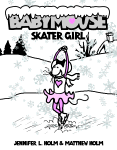
First, I read a couple of the Babymouse books by Jennifer L. Holm and Matthew Holm. I think what makes these books work is that they are graphic novels. While the stories are fine, the basic plots of the two I read, Skater Girl and Puppy Love, weren't particularly unique. But joining those plots with the graphics and the mouse, definitely elevated them.
I found it a little unusual that the books sometimes use a third-person narrator who speaks directly to Babymouse and wondered if kids found that confusing. Presumably not, since there are a lot of Babymouse titles.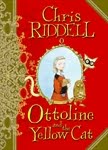
Our library classifies Ottoline and the Yellow Cat by Chris Riddell as a graphic novel, though I think I'd describe it as more of a heavily illustrated novel for younger readers. It's a beautiful looking book with an interesting basic story, though I could have done without the Cousin It-like character, myself. Readers frequently have to stop reading to study the illustrations, which do, indeed, sometimes tell part of the story. (Though sometimes they're just illustrations.) I wondered if young readers would find that frustrating. On the other hand, a young, not-very-enthusiastic reader might find it a relief to stop and enjoy the scenery.
If you go to the Original Artwork From Children's Book Illustrators site, be sure to watch the slideshow of Riddell's Illustrations to Unwritten Books. It's very clever. Among my favorites...Hot Comfort Farm and Wuthering Tights. But there's lots of good stuff there.
Blog: Original Content (Login to Add to MyJacketFlap)
JacketFlap tags: Reader response, Books for Younger Kids, Add a tag
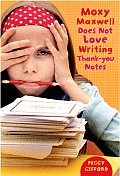
I was in the library earlier this week, looking at all the special powers books on the new books' shelf in the children's area. By which I mean books about kids learning they have special powers or having special powers and going to special schools to develop them or kids in some kind of fantasy world full of special powers. I understand that children enjoy reading the same kinds of things over and over, and I respect their desire to do that. But, man, it's hard for an adult working in kidlit not to keel over from the sameness of it all.
So imagine my delight when I saw a book about something so mundane as writing thank you notes. Really, we have gotten to a point in children's literature where the mundane is unusual.
Some people might think that Moxy Maxwell Does Not Love Writing Thank-you Notes by Peggy Gifford is a little gimmicky. The chapters are short with titles that sort of bleed into them. Take Chapter 25, for instance:
Chapter 25
In Which Mark Says No
"No."
Plus, young Moxy falls asleep at odd times. And the book uses a third-person narrator who sometimes intrudes into the story.
Other people might point out a couple of stereotypes, like the odd little sister and the divorced dad who makes plan to see his kids but never carries through with them.
However, Moxy Maxwell isn't trying to be Anna Karenina (which, to be perfectly honest, I've never been able to get through). Moxy Maxwell is trying to be a light, clever, amusing story about a girl who is close to over-the-top but in a funny way that doesn't have time to get annoying because the book is so short. And it does that very well.
There's a real storyline here about poor Moxy, who must finish writing her Christmas thank you notes before heading to California with her brother to finally visit their father, a former soap opera actor who is out in Hollywood hunting for a Big Deal. We're not talking random jokes or actions, which is what you sometimes find in books for this age group. But what's most admirable about this book is that it's a funny story for younger kids that treats its readers with respect. The author doesn't assume that child readers only laugh at toilet humor and funny sounds. This is lightish entertainment that a kid doesn't have to feel embarrassed about having read.
And a word about the illustrations, which are photographs by Valerie Fisher--the pictures are supposed to be taken by Moxy's brother as the story is taking place. What we have is a little mixed media going here, and it works better than some more sophisticated attempts that I've seen.
I read a paperback edition, which would be perfect for tucking into a camp trunk this summer, or bringing along for a family vacation.
Blog: Original Content (Login to Add to MyJacketFlap)
JacketFlap tags: graphic novels, Books for Younger Kids, Add a tag
Nearly a month and a half ago I decided it had been a while since I'd read a book for younger readers, so I picked one up at the library. It just happened to be a graphic novel. I found out later that I'd be one of the judges for the Graphic Novel Division of the Cybils, which made reading the book I'd already picked up a little more interesting.
The book was interesting in a truly dreadful way. It was one of those degrading younger kid books that relies on what passes for wordplay and stupid humor. It was combined here with gimmicky images that appeared to be there to make kids' eyes pop.
I think that in a graphic novel the images should not just be illustrating scenes. The images should actually take the place of narrative. They should show true action, as in movement of plot.
Take The Invention of Hugo Cabret, for instance. Hugo Cabret isn't a graphic novel, but I think it could be said to have graphic elements. Sections of the story are told through pictures. Those pictures don't just illustrate some text the reader reads. They actually show us what is happening without words. Many of the scenes I recall involve movement. Our hero runs through a train station, under a clock, and up some stairs, while being chased by a guard. None of that is written down anywhere. We see it happen in the images and understand what has happened when the story picks up with text again.
I think that's what's supposed to be going on with a graphic novel. The images aren't supposed to be redundant. They aren't supposed to repeat what we read in a panel. They're supposed to replace the narrative that would occur around dialogue.
All the images did in this book I'm taking about was illustrate. They didn't make the story clearer. In fact, they made the story more confusing. I had trouble telling what had happened at one point.
In addition, what minimal plot exists in this book includes a hefty hole because it's the second book in some kind of series. All of a sudden the main character starts talking about someone from the first book and takes off to see him.
Poor plot, images that don't do what they're supposed to, and lack of respect for readers all work together to create a chaotic piece of writing for an age group that has only recently learned to read.
Why am I not mentioning the title? Because I can't balance the negative with positives here, because I can't think of any. So why I am writing about it at all? Because what I think of as this book's problems as a graphic novel have helped me clarify my thinking about graphic novels in general.
Blog: Original Content (Login to Add to MyJacketFlap)
JacketFlap tags: Books for Younger Kids, Cybils, Add a tag
There's been lots of Cybils news this past week because they're getting the ball rolling for 2008. In my humble opinion, the most exciting Cybils news by far is the addition of a new Easy Reader category. I have gone on at great length about how I think books for younger readers don't get the attention they deserve. A Cybil is just the thing to show respect for books for new readers.
Blog: Original Content (Login to Add to MyJacketFlap)
JacketFlap tags: Books for Younger Kids, Add a tag
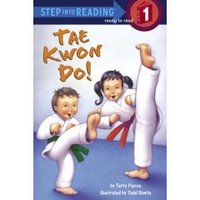
I found this under the attendance sheets at my taekwondo school this morning. I don't have a clue what makes for a good intro reading book, but, hey, this is about taekwondo!
Usually martial arts kid fiction tends to be very moral and preachy. With so little text, I sure didn't see any of that here.
Blog: Original Content (Login to Add to MyJacketFlap)
JacketFlap tags: Books for Younger Kids, Add a tag
The term "chapter book" doesn't mean much, evidently. Yesterday at Seven Impossible Things Before Breakfast Jules and I discussed the lack of agreement about terminology to describe books for new readers. "Chapter book" is only one name used to label shorter books with limited text, somewhat easier vocabulary, and maybe some illustrations written and marketed for children, say, 7 to 9 years old.
Unless, you're The New York Times. Scroll down its Children's Bestseller List until you get to the subtitle "Chapter Books" and check out the age designations after each title. Every book there is either middle grade or YA. It appears that The NYTimes considers the term chapter book to mean "a book with chapters."
To find books for kids under eight- or nine-years-old, at least on this week's list, you have to look under "Series Books" where Junie B. Jones, Fancy Nancy, and The Magic Tree House are listed. They are series books, but isn't Diary of a Wimpy Kid, too? There are two Wimpy Kid books under "Chapter Books."
My regular readers know that I crave order and definition.
Blog: Original Content (Login to Add to MyJacketFlap)
JacketFlap tags: Reader response, Books for Younger Kids, Add a tag
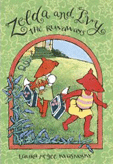
I don't want my blog tour hosts to carry the entire burden of celebrating A Girl, a Boy, and Three Robbers' publication this Thursday, so I've tried to plan a few special things for this week, too. Off and on, I'm going to try to bring some attention to other books for younger kids--since that is what Three Robbers is.
I picked up Zelda and Ivy: The Runaways by Laura McGee Kvasnosky before the last 48 Hour Book Challenge because the title turned up while I was searching a library database for short story collections for kids. These three stories are for very young kids. They don't involve a lot of text and every page includes a charming color picture of the slightly mousie- looking fox sisters, Zelda and Ivy.
The last story, about creating a concoction (which I can remember doing when I was somewhere between five and seven years old) is probably the most creative. The first story, The Runaways, is pretty familiar, being about a couple of kids who run away and then come home when no one misses them. But the first two sentences are so fantastic that I was hooked right away.
"Dad's making cucumber sandwiches for lunch," said Ivy.
"Not again!" said Zelda. "That's it. I'm running away."
Talk about not wasting time on tedious exposition! Talk about introducing conflict early! This intro could be an example in a writing textbook.
Sometimes I don't get animals that think they are humans in kids' books. They work best for me when they are like Zelda and Ivy--characters living as realistic children in happy, comfortable situations, who just happen to be foxes or frogs or toads or pigs.
Three earlier Zelda and Ivy adventures appeared in picture book format.
Blog: Original Content (Login to Add to MyJacketFlap)
JacketFlap tags: Reader response, Books for Younger Kids, Add a tag
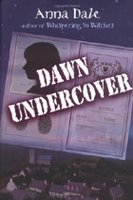
Last weekend there was a conversation going on over at Read Roger about the difference between "an adult reading a children's book recreationally and reading it professionally." It was very timely for me, because I was finishing up reading Dawn Undercover by Anna Dale, and I was definitely having a little problem trying to determine how kids would feel about this book versus how I felt about it.
I felt this book was very well-written, by the way. I was in the market for a spy book for younger kids, and this one is well-done. Dawn Buckle is a bland, nondescript English child who people don't notice. She has to attach herself to other kids in order to cross the street because the crossing-guard would never bother with her otherwise. A recruiter for a spy agency thinks this would make her a gifted spy and signs her up.
Great idea. I loved the set-up, though Dawn has one of those Roald Dahl-type over-the-top and negligent (though in this case only mildly so) families that are common in British books and that I find annoying. But a lot of people don't find them annoying, and I was able to put that aside because they disappear early on.
Dawn then spends nearly half the book being trained as a spy by a lot of adult characters. Her spy story doesn't start until halfway through the book. I think some trimming could have been done there.
Here's the part that bothered me, personally, though--Once Dawn has finished her training and is out on her case, she is no longer the nondescript child I loved at the beginning of the book. That whole aspect of the story seems to just be dropped. Okay, toward the end Dawn realizes that she's changed, and I know change is good, but I liked Dawn the way she was. I would have liked to have seen her use who she was in her adventure. I was disappointed. To me she seemed to have just turned into another run-of-the-mill kid adventure character.
But would a child reader react that way? A child reader, who hasn't read a lot of spunky girl books, might very well appreciate that a friendless, bland little girl could change and become spunky. A child reader might very well want to identify with a character who does that rather than a character who uses her blandness to fight evil.
When I stopped being an adult reading a children's book recreationally and forced myself to be an adult reading a children's book professionally, I decided Dawn Undercover is probably a good child spy story for younger kids.
Blog: Original Content (Login to Add to MyJacketFlap)
JacketFlap tags: Reader response, Books for Younger Kids, Reader response, Books for Younger Kids, Add a tag
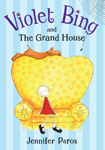
I'm afraid I'm very much like Violet Odelia Bing in Violet Bing and The Grand House by Jennifer Paros. My mind is made up about a great many things. I don't care for kids' books about children with funny names like Violet Odelia Bing. As a general rule, I'm not fond of eccentric great aunts (or uncles, for that matter). I think their freaky old houses have been done to death, too. And third-person narrators who speak directly to readers set my teeth on edge.
And, yet, I like Violet Bing. I even like the Grand House she visits.
I think what makes Violet so attractive to me is that she isn't a cute, funny kid. She is an anxious child. She is "against Surprises and Things I Don't Know." She has an objection to every new experience. Such children aren't going to fall into line easily or quickly or--let's be honest, here--maybe even at all. They certainly aren't going to learn a sweet little lesson from an adult, as so many children in books for younger readers do.
Violet refuses to go on vacation with the rest of the family and has to accept staying with her great-aunt who lives in an odd, "Grand House." Usually in kids' books, the child main character goes to visit the great-aunt in her bizarre old lair and is blown away by what she finds there. Not our Violet. Astrid (she's rarely referred to as "aunt," which is a nice touch) tries to entice her with all the house's charms, its "Things of Interest." But Violet will have none of it. "There is nothing of Interest," she says. In what seems to me to be a bit of a role-reversal, Violet is the eccentric relative here.
Violet does begin to loosen up through the intervention of a dog, a neighbor child, and, you might say, a girl much like herself. Oh, and maybe a spider. But the loosening up is slow, as it would be in real life. This reader, at least, was left with the hope that Violet wouldn't change all that much.
Violet Bing and The Grand House sounds as if it might be the beginning of a series. If that's the case, I'm not sure if a less negative Violet will be as engaging as she was in this first book. But in The Grand House she is an intriguing character for readers in the early grades.
Blog: librarian.net (Login to Add to MyJacketFlap)
JacketFlap tags: librarians, web, 'puters, tek, l2, library2.0, karencoombs, webservices, Add a tag
Karen Coombs explains why web services isn’t just about a better website and also explains what some of the sacred cows are that keep library websites from being better.
[M]eeting your users where they are isn’t about making them come to the library website. In considering our long term virtual presence plans, the library website is a given. People who come to the site know we exist and want to use our services. To truly be successful we have to get our content into the path of the people who wouldn’t walk through our door (physical or virtual).
I like Karen’s talks about her work website specifically because she’s part of a larger team that all needs to work together to roll out new services to their faculty, student and staff population. I feel lucky because I often have carte blanche in the tiny sites for tiny libraries that I design. I also have very little reach with those sites. That’s okay for what I’m trying to do, but if I had to bring together multiple different stakeholders and make them happy with a website — including those designing, for example, for 800 x 600 resolution screens — I’m sure I’d find it very challenging indeed.
I’m en route to Nova Scotia today, speaking at NSLA and at a Learning 2.0 program with Ryan Deschamps, but when I get back I hope to show off my own collaborative project, turning the Vermont Library Association site into a bloggish group-maintained site from a static single-admin site. It’s gotten so that I have enough WordPress admin login pages to keep track of that I’ve shunted them into their own folder on my bookmarks toolbar. Exciting times!
karencoombs, l2, library2.0, tek, web, webservicesBlog: librarian.net (Login to Add to MyJacketFlap)
JacketFlap tags: vla, associations, chic, karencoombs, ala, Add a tag
Karen Coombs talks about a reaction she had a while back to a comment on her blog where she was considering her commitment to the Texas Library Association. I think for many busy librarians the question of how much to participate in how many professional associations is one that we have to continually revisit. There is also the related question of how long you need to try at something before you decide it’s not working and moving on to trying something else.
After I cycled off ALA Council, I decided that I wanted to step back some and spend sometime reacquainting with my local library association in Vermont, so I didn’t renew my ALA membership. I joined VLA at the conference — where I gave two talks, or I gave half of two talks — which meant that my annual fee will only pay for seven months of membership (all memberships expire on 31dec. That said, membership is cheap). I didn’t feel obligated to join since I’m not technically a librarian for my job but I felt it would be a good idea. Before I officially joined, I was still receiving the newsletter and I was on the mailing list, so I’m not sure what joining technically gets me except the ability to be elected to an office which is not something I’m seriously considering at this point. I joined a committee — the advocacy committee — but had a difficult time making the meetings that were scheduled a few weeks in advance all over the state. Most meetings at VLA seem to happen in person. My speciality is, as you know, online communications and tools so a lot of what I had to offer the committee — custom RSS feeds and news filters, custom email addresses, web site updates, blog creation, “email your legislature”, setting up little websites — were all sort of outside the range of what we were considering and no one on the committee had access to the VLA website to make changes to it. I did manage to get the Library Value Calculator up on the website, but it involved a few days of work just getting that to happen and when it was announced on the list, my name wasn’t mentioned. This is a world I am getting used to.
Meredith has written a little bit about our experiences working with VLA. Unlike in a giant organization like TLA, I know most of the members of VLA either personally or by sight. It’s a tiny state. Membership is up from the high 200’s to about 400 now which is pretty exciting. I had a great time at the conference and I introduced myself personally to the incoming president who I heard had some bold new ideas for getting the word out about the importance of libraries (making the newsletter not a perk for members only, ditching the print newsletter in favor of a digital one, using email and blogs for communicating, more online communication and tools etc). What I told her, which is true, was that I’m not blessed in the tact department but if there is a computer or technological problem that needs fixing, I’m one of the more capable library people in the state to do it. The VLA conference allowed me to meet a few more people in the state who are also capable and techie and I have a slow but inexorable plan to Make Things Work Well. I’ll check back in next year and let you know how it’s gone.
ala, associations, chic, karencoombs, vla





That is just so cool--that's why we children's writers write!
I thought the story was both moving and practical. It was terrific to hear about a child so enthused about reading a book, but the title involved also got a lot of promotion among those kids and even generated a couple of sales. The buzz may move on to the school's librarian and other professionals in the building. Since it's the first book in a series, getting some name recognition is important for the books that will be published down the line.
This is amazing! Word of mouth isn't just a marketing buzzword.